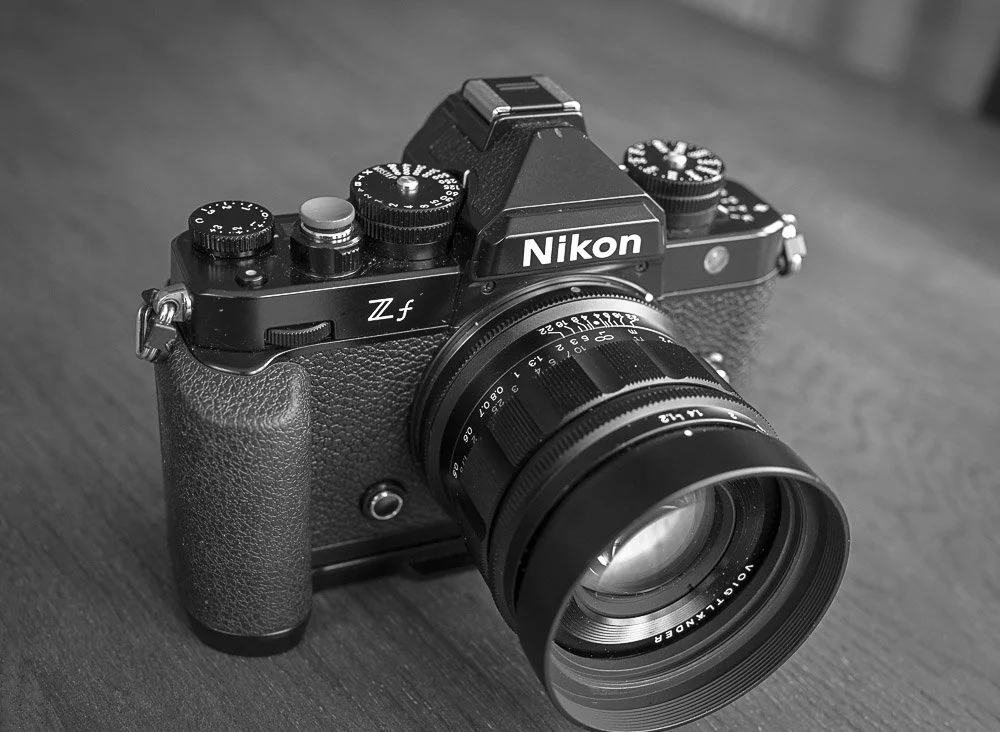The Nikon Zf Photographer Experience
The Nikon Zf with the Voigtlander Nokton 40mm lens
New Camera for Street Photography
I’ve owned my Nikon Zf for around five months, managing to get a deal on Amazon that reduced the retail price by around 20%, although it did arrive in an open box and without a battery. Due to the poor vendor selection, my early impression of the camera was distorted by my purchase experience, but that quickly changed once I started using the camera. Prior to 2025, most of my work had been predominately landscape and seascape photography, using my trusted Nikon Z7II. I occasionally ventured into street photography because the genre interested me and I was inspired by some of the UK street photographers now becoming famous across the world. Although the Nikon Z7II is a great camera, especially for landscape and seascape photography, the accompanying Nikon lenses were often large and bulky, giving (in my opinion) an obtrusive experience while shooting street. I not only needed a system that was less obvious but something to separate my landscape photography from my street photography. But, what to buy? Having owned Nikon DSLRs and Fujifilm XT3 mirrorless systems in the past, I wished to avoid returning to a system with different brand cameras and lenses. And, along came the Nikon Zf.
I have always had a passion for old style cameras but never thought I would miss them. The Nikon FM2 inspired Nikon Zf looked absolutely beautiful, the FM2 design is a legend in photography, and the manual focused body, which could be switched to automatic if desired, was very appealing. To be honest, I had never considered a retro looking camera until I came across the Nikon Zf, but it very quickly caught my attention.
Photographer’s Experience
As someone who has used only manual mode for the last five or so years, I now struggle using other automatic modes, so I can’t really comment on those modes. However, the Nikon Zf has been made for the manual mode photographer. The placement of the dials makes manual mode so easy, and muscle memory is now beginning to take place that allows me to automatically switch settings while still looking through the electronic view finder (EVF). More importantly, the ability to switch the LED screen inwards, so that it is protected and avoids distraction, is also a bonus and definitely adds to that retro feel from the camera. The full frame 24.5 MP sensor, processed by the EXPEED 7 engine, provides powerful results and especially in low light situations. The in body camera stabilisation also provides confidence in shooting in low light and I’ve rarely missed a shot due to camera movement. The camera does feel like a brick due to its weight and size, but this also provides a confidence of the weather sealing and high quality build that is evident.
Without a doubt, the Nikon Zf has been one of the best cameras I’ve ever purchased in the last twenty years. And, although I would still use my Nikon Z7II for landscape and seascape photography, the Nikon Zf has become my go to camera for dedicated street, travel and architecture photography days. It is an absolute pleasure to use and it’s one of those cameras that you look at and feel a deep connection with. This has been amplified with the adoption of manual focused lens, such as the Voigtlander Nokton 40mm, the Voigtlander 14mm, and the Thypock 28mm lenses. These lenses, now available in Z mounts and with high quality build, really do make the Nikon Zf flourish. Manual lenses enhance the retro experience and, quite frankly (in my opinion), the manual focus zone approach is more suited to street photography. Unfortunately, they are not weather sealed so, on rainy days, I still use my Nikon Z 35 S Line lens, which also works perfect with the retro experience. I also own the pancake Nikon Z 40mm lens, but this is a little like marmite in that, it is a great lens with good results, but the overly plastic feel often deters me from using it.
A Professional Orientated Camera with a Fun Factor
To summarise, I now wouldn’t be without my Nikon Zf. When using the camera, I feel strongly connected to it as though it is part of my artistic workflow other than a tool. The best way to explain this is that when I’m using the Nikon Z7II for landscape and seascape photography, the camera is a tool in recreating the scene surrounding me. The Nikon Z7II is a great camera and I have no need to replace it for landscape or seascape photography, but it is a tool, nothing more. The Nikon Zf is more than a tool for taking good photographs, it’s become part of the enjoyment - even when the scene around me is not fantastic. I am definitely looking forward to see how Nikon mature the Nikon Zf. Some say that the 24.5 MP is a limitation? My advise is to try the camera and experience it. I assume this is how the Leica photographers feel about the Q and M series cameras - the camera becomes part of the photographer and the overall enjoyment of taking photographs.
Not only super cool to look at - but a very powerful professional camera

